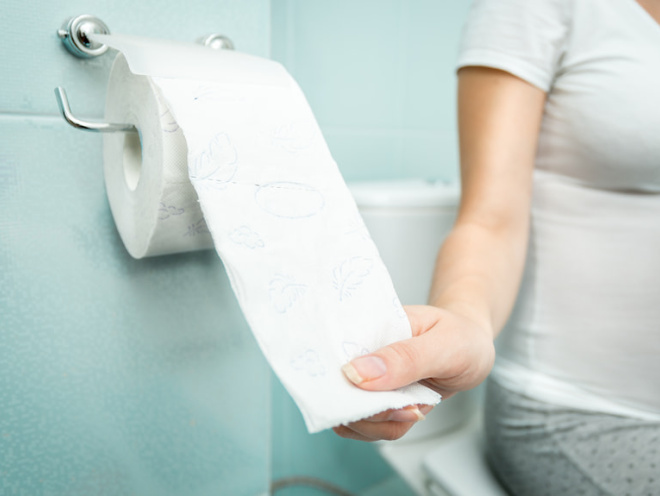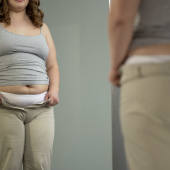It’s a subject a few people talk about. Here’s the truth about pregnancy and post-pregnancy urinary incontinence.
1. Urinary incontinence: what it is
Urinary incontinence is weeing or leaking urine without meaning to (NHS, 2016a). Pregnant women sometimes can’t stop themselves from leaking wee when they cough, laugh, sneeze, move suddenly, do exercise or just get up from a sitting position (NHS, 2018).
2. What causes urinary urgency or incontinence in pregnancy?
The most common cause of pregnancy-related urinary incontinence or urgency is weak pelvic floor muscles (the muscles around the bladder) (CSP, 2017). This might be temporary as the pelvic floor muscles relax to prepare for labour (CSP, 2017).
Pelvic floor muscles support the uterus and help control the bladder and bowel. The weight of your baby can weaken these muscles.
3. What causes urinary urgency or incontinence after childbirth?
Another thing that weakens your pelvic floor muscles is, of course, giving birth. The pressure inside your bladder becomes greater than the strength of your urethra to stay closed and any sudden extra pressure sees wee leak out (NHS, 2016a).
Your urethra might not be able to stay closed if your pelvic floor muscles are weak or damaged. Alternatively, the muscle that keeps the urethra closed might be damaged. These problems may be caused by damage during vaginal births (NHS, 2016a).
4. Epidurals and spinal blocks may affect urinary incontinence
If you had an epidural or a spinal block, for a few days after birth you may not be able to tell when you need to wee. If you had an epidural, the catheter that was inserted into your bladder might make it harder for you to control when you wee too (NHS, 2017a). But this should get better within a few days.
5. Urinary incontinence is super common
In the three months after childbirth, a third of women suffer from incontinence (Thom and Rortveit, 2010). Yet a third of those women were embarrassed about mentioning it to their partners and almost half with friends (NCT, 2016).
Even more worrying? Almost 38% of women said they were self-conscious speaking about the problem with a healthcare professional (NCT, 2016).
"Incontinence is curable but only if you get help from a midwife, GP or health visitor (NHS, 2018)."
6. Pelvic floor exercises are key
If you're pregnant or planning to get pregnant, you should start doing pelvic floor exercises straight away (NHS, 2017c). This will lower your risk of experiencing incontinence after you have your baby (BAUS, 2017; CSP, 2017; NHS, 2017b).
Do your pelvic floor exercises even if you haven’t had any leaks or dashes to the loo as they will improve your bladder control (NHS, 2017b). Find out how to do them here.
As long as the birth was straightforward, start the exercises again as soon as you feel up to it (NHS, 2016c). If you had stitches, start lying down and work your way up to doing them while sitting. Start with gentle, short, pelvic floor muscle squeezes.
If you had ventouse, forceps or a caesarean, start your pelvic floor muscle exercises once any urinary catheter has been removed and you are weeing normally.
Don't assume you don't have to do these exercises if you've had a caesarean. Being pregnant in itself can weaken your pelvic floor muscles so you’re still at risk of bladder and bowel problems (sorry…).
As you feel more comfortable, squeeze a little harder and add in your long squeezes again. Gradually build up how many squeezes you do, and how long you hold. Try to do this four to five times per day. Once your baby is feeding well, put your favourite Netflix show on and you’ll find this is the perfect time for your exercises.
7. There are other ways to help your bladder
As well as doing your pelvic floor exercises:
- cut down on caffeine
- avoid spicy and acidic foods
- drink six to eight glasses of fluid a day but no more (many people with urinary incontinence avoid drinking fluids but this worsens it by reducing your bladder capacity)
- be a healthy weight
- quit smoking
- avoid lifting.
(NHS, 2016b)
8. There is specialist treatment available
If you have any concerns, ask your GP for a referral to a women’s health physiotherapist. You should receive at least three months of supervised pelvic floor muscle training, for starters (CSP, 2017).
9. Consider the possibility of a urinary tract infection (UTI)
Sometimes, having no control over when you wee is caused by a urinary tract infection (UTI) (NHS, 2017d). UTIs can affect different parts of your urinary tract, including your bladder (cystitis), urethra (urethritis) or kidneys (kidney infection). Most UTIs can be easily treated with antibiotics (NHS, 2017d).
Symptoms of a UTI include:
- needing to wee suddenly or more often than usual
- blood in your wee
- pain in your lower tummy
- feeling tired and unwell
- pain or a burning sensation when you wee
- cloudy wee
- unpleasant-smelling wee
- fever.
(NHS, 2017d)
Contact your doctor or midwife immediately if you have any of these symptoms because you might need antibiotics (NHS, 2017d).
10. It’s crucial to break the taboo
Many women who get incontinence issues after they have a baby keep it quiet because they are embarrassed (CSP, 2017). Yet the condition is so common. It’s certainly nothing to be embarrassed about.
Not seeking help can leave you feeling lonely, affect relationships and careers, and can stop you exercising or having sex. So take a deep breath and speak to friends, midwives and partners about what’s happening to you. You’ll feel relieved, supported and then you can start to get help and move on too.
This page was last reviewed in May 2018
Further information
Our support line offers practical and emotional support with feeding your baby and general enquiries for parents, members and volunteers: 0300 330 0700.
The Chartered Society of Physiotherapy (CSP) has lots of useful information about pregnancy-related incontinence.
You can also use the CSP’s Physio2U service to find a local practitioner or contact the Pelvic Obstetric and Gynaecological Physiotherapy group.
Read more about the evidence around incontinence.
NHS Choices has helpful information about urinary incontinence including symptoms and treatment.
BAUS (2017) Information from The British Association of Urological Surgeons (BAUS) about pelvic floor exercises. Available from: www.baus.org.uk/_userfiles/pages/files/Patients/Leaflets/Pelvic%20floor%20XS%20female.pdf (Accessed 1st May 2018).
CSP (2017) Pregnancy-related incontinence. Available from: http://www.csp.org.uk/your-health/conditions/pregnancy-related-incontinence (Accessed 1st May 2018).
NCT (2016) Breaking the taboo of incontinence after childbirth. Available from: https://nct.org.uk/press-release/breaking-taboo-incontinence-after-childbirth (Accessed 1st May 2018).
NHS (2016a) Urinary incontinence. Available from: https://www.nhs.uk/conditions/urinary-incontinence/ (Accessed 1st May 2018).
NHS (2016b) 10 ways to stop leaks. Available from: https://www.nhs.uk/conditions/urinary-incontinence/10-ways-to-stop-leaks/ (Accessed 1st May 2018).
NHS (2016c) Keeping fit and healthy with a baby. Available from: https://www.nhs.uk/conditions/pregnancy-and-baby/keeping-fit-and-healthy/ (Accessed 1st May 2018).
NHS (2017a) Epidural. Available from: https://www.nhs.uk/conditions/epidural/side-effects/ (Accessed 1st May 2018).
NHS (2017b) What are pelvic floor exercises? Available from: https://www.nhs.uk/chq/pages/1063.aspx?categoryid=52 (Accessed 1st May 2018).
NHS (2017c) Exercise in pregnancy. Available from: https://www.nhs.uk/conditions/pregnancy-and-baby/pregnancy-exercise/#pelvic-floor (Accessed 1st May 2018).
NHS (2017d) Urinary tract infections (UTIs) Available from: https://www.nhs.uk/conditions/urinary-tract-infections-utis/ (Accessed 1st May 2018).
NHS (2018) Common health problems in pregnancy. Available from: https://www.nhs.uk/conditions/pregnancy-and-baby/common-pregnancy-problems/#incontinence (Accessed 1st May 2018).
Sangsawang B, Sangsawang N (2013) Stress urinary incontinence in pregnant women: a review of prevalence, pathophysiology, and treatment. Available from: https://www.ncbi.nlm.nih.gov/pmc/articles/PMC3671107/ (Accessed 1st May 2018).
Thom DH, Rortveit G (2010) Prevalence of postpartum urinary incontinence: a systematic review. Available from: https://www.ncbi.nlm.nih.gov/pubmed/21050146 (Accessed 1st May 2018).





